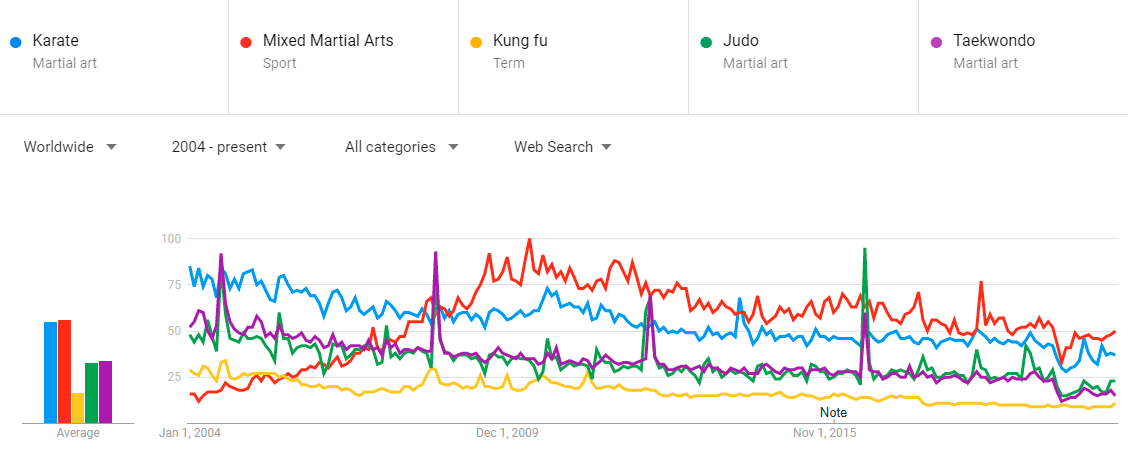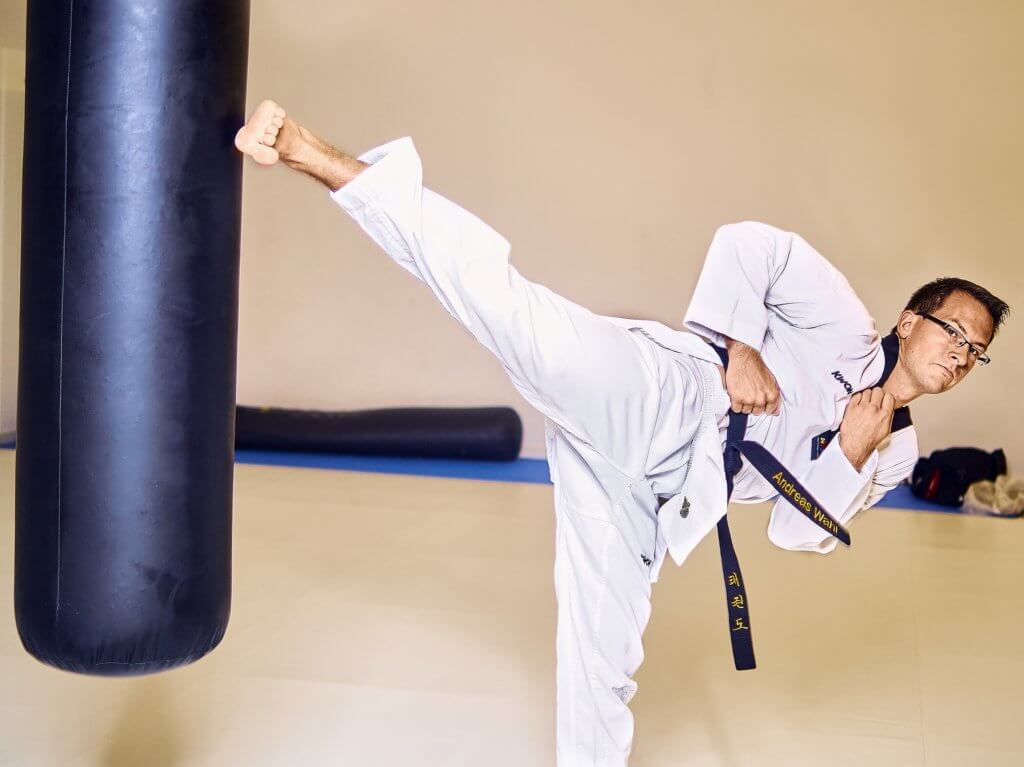Martial arts are systems of combat used for self-defense, physical training, and spiritual growth.
There are many different types of martial arts practices. These include striking martial arts, take-down martial arts, grappling martial arts, and hybrid martial arts. On the farthest ends of the spectrum martial arts can also be practiced with weapons, like in Kali, or practiced for meditation, like in Tai-Chi.
Skip to Most Popular Martial Arts
But which practices make up the most popular martial arts in the world? As providers of martial arts software, we were interested to find out.
Determining the Most Popular Martial Arts
Determining the most popular martial arts in the world is a tricky task. Although some martial arts have representative bodies working to select national martial arts teams, individual registration numbers are often unknown.
So, when we decided to rank the Top 5 martial arts in the world, we chose ‘interest’ as the decisive indicator. This means we looked at which martial arts people search for most often.
To be clear, this interest measurement does not take into account TV audience data, participant registration data or any other comparative data. Instead, we focused solely on search data.
In order to uncover this data, we used Google Trends to measure interest over time. Leveraging this tool, we determined that the following are the top five most popular martial arts in the world.

Analyzing Martial Arts Interest Data
We looked at interest measurements beginning in 2004, which is as far back as Google Trends can measure. In the above graph, the level of interest is given as a measurement out of 100.
Several different types of martial arts were measured but do not appear in the above graphic. Honorable mentions that fall outside the top 5 martial arts include: Muay Thai, Brazilian Jiu jitsu, Aikido, and Krav Maga.
When reviewing the graph, it’s clear that Judo and Taekwondo have seen four separate bursts of popularity (more on that below).
It’s also clear that Mixed Martial Arts has achieved the highest sustained level of popularity including a notable period of popularity lasting from August 2009 to April 2012.
What follows is a breakdown of the top 5 martial arts in the world. Below, we dive into the characteristics and origins of each of the world’s most popular martial arts, and explain their spikes in popularity.
(UPDATE: The original data used for this article showed that Kung Fu had generated two separate interest spikes near 100. Karate also saw one spike near 100. In the updated data (extending to 2021), these spikes have been removed by Google Trends. It’s suspected that this data was removed because each interest spike was related to films about Kung Fu and Karate. As a result, the most popular martial arts in the world have been adjusted accordingly.)
1) Mixed Martial Arts: the Most Popular Martial Art in the World
Mixed martial arts (MMA) is a practice of hybrid martial arts which blends all forms of combat. There are plenty of theories about who founded mixed martial arts. But there is no doubt that its sudden increase in popularity comes from the Ultimate Fighting Championship (UFC).
As an organization, the UFC runs a reality television show and several pay-per-view championship fights throughout the year.

Some people criticize UFC fights for their gratuitous violence, however, it’s more technical than it appears.
Each championship fight seeks to answer two questions at once. UFC fights aren’t just determining who the better athlete is, they’re also determining which combat style is best. For example: if a fighter who specializes in Brazilian Jiu Jitsu beats a fighter who specializes in Muay Thai, Brazilian Jiu Jitsu will be seen as the most important martial art in an MMA fighter’s arsenal. So, although some fights may look barbaric at times, there are more forces at play than a simple boxing match.
Who founded MMA?
Among the founding forces, Bruce Lee has been hailed as the father of modern MMA, according to UFC founder Dana White. Lee’s practice of Jeet Kune Do was a synthesis of Kung Fu, Muay Thai, Boxing, Wrestling, Jiu jitsu, and more. This mixed martial art is quite similar to the combat style that the UFC sees inside the octagon today.
Of course, the idea of mixing combat styles is as old as time.
The ancient art of Greek Olympic hand-to-hand combat, known as pankration, allowed all forms of fighting except eye gouging and biting. For this reason, some point to the practice of pankration as the real inspiration for mixed martial arts.
Regardless of it’s origins, viewer interest has been captured by mixed martial arts events across the globe.
In the graph above, the mixed martial arts interest line steadily climbs from 2004 to 2009 where it meets karate. From 2009 to 2012 the UFC experienced the rise of some of its most iconic fighters and spectacles including Georges St-Pierre, Anderson Silva, B.J. Penn, and Brock Lesner. From this point onward MMA has succeeded karate as the most popular martial arts in the world.
2) Karate Still Benefits from it’s Early Adoption in Hollywood
Karate is one of the striking martial arts that heavily emphasizes self-defense and counter-striking your opponent. Kicks, punches and a wide, strong stance are staples of karate, along with a deep spiritual practice.

In the 19th century, the Father of Modern Karate, Gichin Funakoshi, explained that the main purpose of karate is to perfect the self. In fact, in one of his 20 precepts, he states, “spiritual development is paramount; technical skills are merely a means to an end.” From this, it’s clear that karate should be interpreted as a spiritual practice first and a physical practice second.
When did Karate reach the United States?
Grandmaster Robert Trias formalized the practice of karate in the United States. Trias was a boxing champion who was introduced to karate while stationed in the Solomon Islands during WWII. After his introduction, he sought-out further martial arts education from numerous teachers in Japan, China and Hawaii before returning to Arizona, USA and founding the first known martial arts school in the continental United States.
Ten years later, in 1955, Trias wrote the rules for karate competition and conducted the first karate tournament.
As karate was gaining popularity across the United States in the 1960s, Bruce Lee rose to stardom.
Bruce Lee’s speed, talent and showmanship brought martial arts into the Hollywood limelight. Following Lee, Chuck Norris and several other stars kept martial arts like karate front and center in action films of the 1970s, helping propel its popularity.
By the 1980s the popularity of karate reached fever-pitch with the release of The Karate Kid in 1984. Following its success, kids flocked to dojos across the United States hoping to learn the storied martial art.
Thanks to this early adoption of Karate in Hollywood, Karate is still top-of-mind for many people today.
3) Taekwondo: A New Olympic Martial Art
Taekwondo is a Korean martial art that draws upon several different martial arts including karate, Chinese martial arts and Taekkyeon.
The practice is defined as a stand-up or striking martial art that includes some joint-lock maneuvers. Much like karate, Taekwondo emphasizes spiritual development, pushing students to strive for harmony and unity between their mind and body.

Although it’s martial arts roots reach through hundreds of years in history, Taekwondo was created in the 1940s and 1950s. The controversial figure, Choi Hong Hi is seen as the Father of Taekwondo, creating the sport during the WWII era. Despite his exile from South Korea, he is credited with having written the first book on Taekwondo, founding the International Taekwondo Federation, and traveling the world to teach the martial art.
The work of the International Taekwondo Federation and World Taekwondo Federation (formed in 1973) appear to have paid off because the popularity of the martial art is now global. In 1988 Taekwondo debuted as an Olympic Sport demonstration before being introduced as a medal sport at the 2000 Sydney Olympic games. This explains why interest in Taekwondo spikes every four years in tandem with the Olympic games.
4) Judo: the First Olympic Martial Art
Judo is a Japanese martial art whose roots come from Jiu jitsu. Founded by Kanō Jigorō in 1882, Judo is one of the takedown martial arts that includes joint-lock maneuvers and limited striking.

The mantra “maximum efficient use of energy” best summarizes the practice of Judo. This axiom builds upon one of the most important principles of Jiu jitsu which directs students to use an enemy’s strength against them. This concept is known as jū yoku gō o seisu or “softness controls hardness” whereby flexibility can overpower rigidity in your opponent by evading attacks to force your opponent off-balance.
On a societal level, Kanō Jigorō founded Judo to provide a way for people to learn the fundamental truths of life.
Through Jigorō’s teachings, the mantra of “maximum efficient use of energy” can be distilled down to “maximum efficiency” which he suggests is “most effectively using one’s energy for a good purpose.” From this it’s evident that, like Karate and Taekwondo, the spiritual practice of Judo is central to its design.
In 1964 Judo became the first martial art to achieve medal status at the Olympic games.
By being named an Olympic sport in 1964, Judo was able to secure a spot in the public eye. When you review the graph above, you can see a spike in interest that occurs every four years, just like Taekwando. These spikes always correspond to the hosting of the Olympic games.
5) Kung Fu
Kung Fu or Wushu are terms often used to refer to Chinese martial arts. This form of martial arts encompasses hundreds of different types of martial arts that have developed over numerous centuries.

The founding of Kung Fu is said to have taken place at the Shaolin temple, a Buddhist monastery, in 527 A.D.. Its purpose was to improve the health, strength and vitality of the monks who lived there. From these beginnings, Chinese martial arts spread across the country and evolved over millennia.
To the untrained eye, Kung Fu and Karate practices seem to involve the same kicks and strikes. Both martial arts also emphasize physical and spiritual development in tandem.
However, among the many different nuances, there is one differentiation between Karate and Kung Fu that can be easily observed. Stiffer, stop and go movements define Karate, whereas more flowing, circular movements define Kung Fu. As a result, Kung Fu movements performed in succession may look more like one long flowing routine. Conversely, Karate strikes and kicks performed in succession are easier to see as separate and distinct movements.
Although Kung Fu predates the origin of Karate, the latter spread quickly across the United States and became the dominant form of martial arts practiced in America. Even though popular films like Kung Fu Panda have kept Kung Fu in the popular vernacular for the next generation, it hasn’t benefited from Hollywood the same way Karate has.
The Most Popular Martial Arts Benefit from TV & Film
The most popular martial arts in the world each have one thing in common; they all benefit from film or television broadcast. By analyzing the interest graph above, we can see clear climbs and spikes in popularity thanks to these mediums.
This is not to say that television and film are the only reasons why these martial arts are popular. But, the there is no doubt that film and television coverage clearly boost interest in each sport across the world.
Will these practices still make up the Top 5 martial arts in a decade? Well, that may just depend on their future coverage.
Have comments about our top 5 martial arts findings?
Feel free to get in touch on Twitter, Facebook, or Instagram. We’d love to hear from you!








